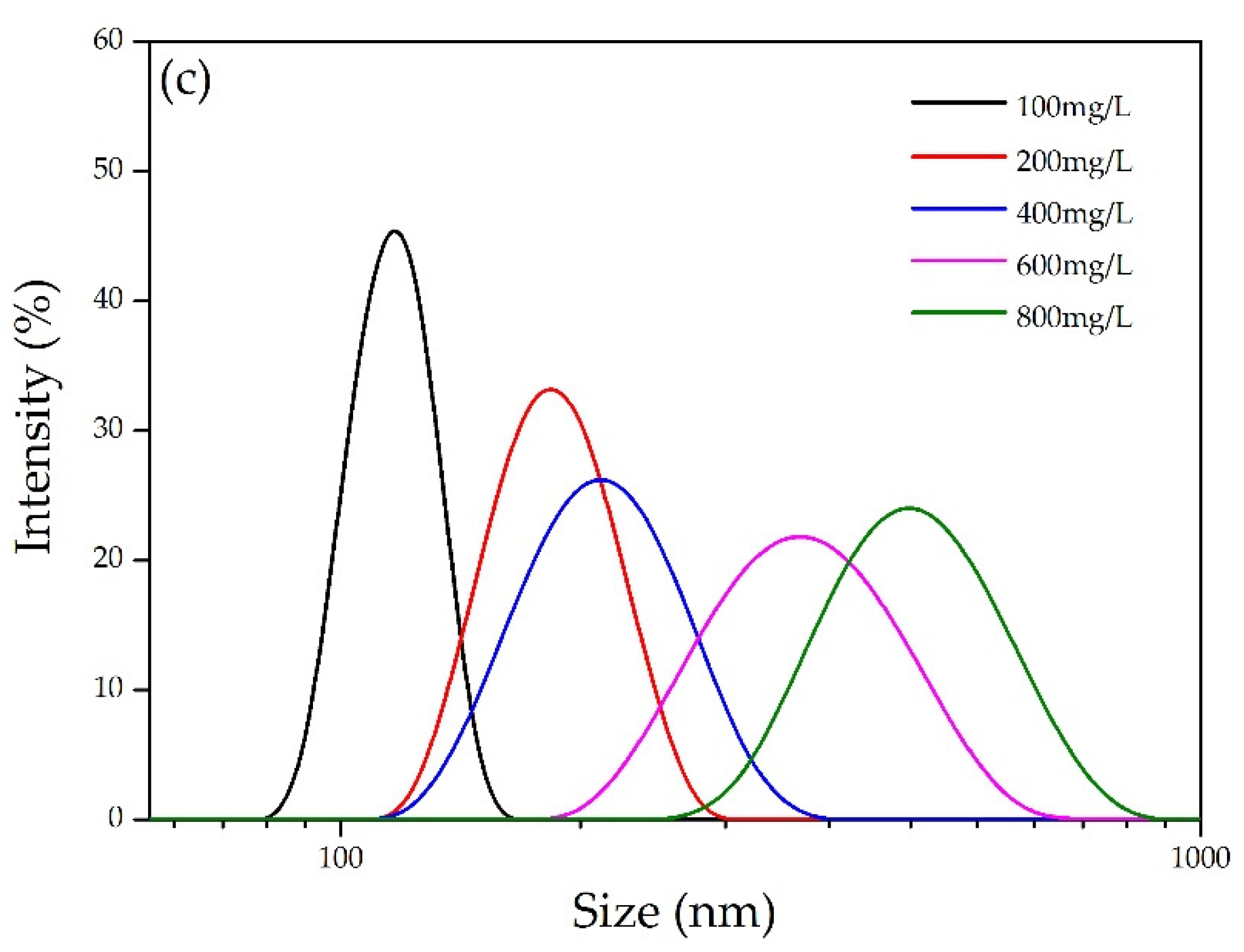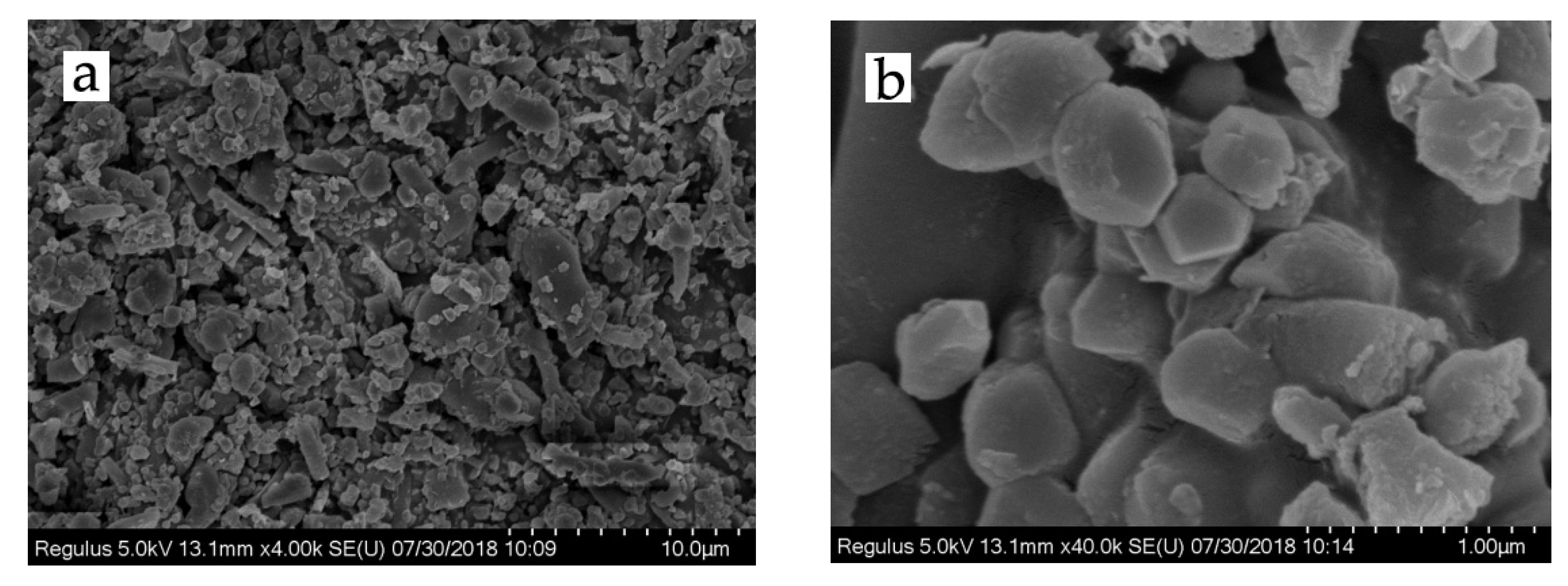Self-Assembly Preparation of Nano-Lignin/Cationic Polyacrylamide Complexes
Abstract
1. Introduction
2. Materials and Methods
2.1. Materials
2.2. Nano-Lignin Preparation
2.3. Characterization
3. Results and Discussion
3.1. Self-Assembly Proocess
3.2. Dynamic Groeth of Nano-Lignin
3.3. Topography Analysis
3.4. Nano-Lignin Fluorescence Intensity Analysis
4. Conclusions
- Nano-lignin was prepared via a self-assembly method using calcium lignosulfonate (CL) and cationic polyacrylamide (CPAM). Dynamic light scattering analysis was used to measure the particle sizes of nano-lignin in the aqueous phase. The CL/CPAM complexes were observed to grow exponentially over a short period of time (30 min). The solid CL/CPAM complexes obtained from lyophilization were oblate spheroid in shape.
- A mass ratio of 100:1 CL-to-CPAM was used for nano-lignin preparation. A high concentration of CL is preferred to maximize the production efficiency of nano-lignin.
- The sizes of the nano-lignin particles exponentially increased over a 30-min time interval; this growth rate is positively correlated with the CL concentration. To obtain nano-lignin with relatively small sizes, it is necessary to quench the growth by lyophilization.
- The fluorescence emission intensity increased as the concentration of CL increased. When the CL concentration was 600 mg/L, the fluorescence intensity was 215 a.u.; when the CL concentration was higher than 600 mg/L, the fluorescence emission intensity decreased. When the CL concentration was at 400 mg/L, the fluorescence emission intensity was at its maximum value; this emission intensity gradually decreased as the CL concentration increased from 400 to 600 mg/L.
Author Contributions
Funding
Institutional Review Board Statement
Informed Consent Statement
Data Availability Statement
Conflicts of Interest
References
- Yang, W.; Kenny, J.M.; Puglia, D. Structure and properties of biodegradable wheat gluten bionanocomposites containing lignin nanoparticles. Ind. Crop. Prod. 2015, 74, 348–356. [Google Scholar] [CrossRef]
- Vanholme, R.; Morreel, K.; Ralph, J.; Boerjan, W. Lignin engineering. Curr. Opin. Plant Biol. 2008, 11, 278–285. [Google Scholar] [CrossRef] [PubMed]
- Vainio, U.; Maximova, N.; Hortling, B.; Laine, J.; Stenius, P.; Simola, L.K.; Gravitis, J.; Serimaa, R. Morphology of dry lignins and size and shape of dissolved kraft lignin particles by X-ray scattering. Langmuir ACS J. Surf. Colloids 2004, 20, 9736–9744. [Google Scholar] [CrossRef] [PubMed]
- Laurichesse, S.; Avérous, L. Chemical modification of lignins: Towards biobased polymers. Prog. Polym. Sci. 2014, 39, 1266–1290. [Google Scholar] [CrossRef]
- Zhang, Q.; Li, H.; Guo, Z.; Xu, F. High Purity and Low Molecular Weight Lignin Nano-Particles Extracted from Acid-Assisted MIBK Pretreatment. Polymers (Basel) 2020, 12, 378. [Google Scholar] [CrossRef] [PubMed]
- Shikinaka, K.; Nakamura, M.; Otsuka, Y. Strong UV absorption by nanoparticulated lignin in polymer films with reinforcement of mechanical properties. Polymer 2020, 190. [Google Scholar] [CrossRef]
- Shikinaka, K.; Fujii, N.; Egashira, S.; Murakami, Y.; Nakamura, M.; Otsuka, Y.; Ohara, S.; Shigehara, K. Polyfunctional nanometric particles obtained from lignin, a woody biomass resource. Green Chem. 2010, 12, 1914–1916. [Google Scholar] [CrossRef]
- Wei, L.; Agarwal, U.P.; Matuana, L.; Sabo, R.C.; Stark, N.M. Performance of high lignin content cellulose nanocrystals in poly(lactic acid). Polymer 2018, 135, 305–313. [Google Scholar] [CrossRef]
- Baurhoo, B.; Ruiz-Feria, C.A.; Zhao, X. Purified lignin: Nutritional and health impacts on farm animals—A review. Anim. Feed Sci. Technol. 2008, 144, 175–184. [Google Scholar] [CrossRef]
- Ugartondo, V.; Mitjans, M.; Vinardell, M.P. Comparative antioxidant and cytotoxic effects of lignins from different sources. Bioresour. Technol. 2008, 99, 6683–6687. [Google Scholar] [CrossRef] [PubMed]
- Kargarzadeh, H.; Galeski, A.; Pawlak, A. PBAT green composites: Effects of kraft lignin particles on the morphological, thermal, crystalline, macro and micromechanical properties. Polymer 2020, 203. [Google Scholar] [CrossRef]
- Ago, M.; Okajima, K.; Jakes, J.E.; Park, S.; Rojas, O.J. Lignin-Based Electrospun Nanofibers Reinforced with Cellulose Nanocrystals. Biomacromolecules 2012, 13, 918–926. [Google Scholar] [CrossRef] [PubMed]
- Shulga, G.; Vitolina, S.; Shakels, V.; Belkova, L.; Cazacu, G.; Vasile, C.; Nita, L. Lignin separated from the hydrolyzate of the hydrothermal treatment of birch wood and its surface properties. Cell. Chem. Technol. 2012, 46, 307–318. [Google Scholar]
- Pereira, A.A.; Martins, G.F.; Antunes, P.A.; Conrrado, R.; Pasquini, D.; Job, A.E.; Curvelo, A.; Ferreira, M.; Riul, A.; Constantino, C. Lignin from sugar cane bagasse: Extraction, fabrication of nanostructured films, and application. Langmuir ACS J. Surf. Colloids 2007, 23, 6652. [Google Scholar] [CrossRef] [PubMed]
- Nair, S.S.; Sharma, S.; Pu, Y.; Sun, Q.; Pan, S.; Zhu, J.Y.; Deng, Y.; Ragauskas, A.J. High Shear Homogenization of Lignin to Nanolignin and Thermal Stability of Nanolignin-Polyvinyl Alcohol Blends. ChemSusChem 2014, 7, 3513–3520. [Google Scholar] [CrossRef] [PubMed]
- Gilca, I.A.; Popa, V.I.; Crestini, C. Obtaining lignin nanoparticles by sonication. Ultrason. Sonochem. 2015, 23, 369–375. [Google Scholar] [CrossRef]
- Ragauskas, A.J.; Beckham, G.T.; Biddy, M.J.; Chandra, R.; Chen, F.; Davis, M.F.; Davison, B.H.; Dixon, R.A.; Gilna, P.; Keller, M. Lignin Valorization: Improving Lignin Processing in the Biorefinery. Science 2014, 344, 1246843. [Google Scholar] [CrossRef] [PubMed]
- Kilpel?Inen, I.; Xie, H.; King, A.; Granstrom, M.; Heikkinen, S.; Argyropoulos, D.S. Dissolution of wood in ionic liquids. J. Agric. Food Chem. 2007, 55, 9142–9148. [Google Scholar] [CrossRef] [PubMed]
- Yiamsawas, D.; Baier, G.; Thines, E.; Landfester, K.; Wurm, F.R. Biodegradable lignin nanocontainers. RSC Adv. 2014, 4, 11661–11663. [Google Scholar] [CrossRef]
- Qi, L.; Liu, W.; Lei, Y.; Zu, Y.; Zu, B.; Zhu, M.; Ying, Z.; Zhang, X.; Zhang, R.; Sun, Z. Investigation of the effects of different organosolv pulping methods on antioxidant capacity and extraction efficiency of lignin. Food Chem. 2012, 131, 313–317. [Google Scholar]
- Grigg, R.B.; Bai, B. Calcium lignosulfonate adsorption and desorption on Berea sandstone. J. Colloid Interface 2004, 279, 36–45. [Google Scholar] [CrossRef] [PubMed]
- Wang, Z.; Zhu, J.Y.; Fu, Y.; Qin, M.; Shao, Z.; Jiang, J.; Yang, F. Lignosulfonate-mediated cellulase adsorption: Enhanced enzymatic saccharification of lignocellulose through weakening nonproductive binding to lignin. Biotechnol. Biofuels 2013, 6, 1–11. [Google Scholar] [CrossRef] [PubMed]
- Constant, S.; Wienk, H.; Frissen, A.E.; Peinder, P.D.; Boelens, R.; Es, D.V.; Grisel, R.; Weckhuysen, B.M.; Huijgen, W.; Gosselink, R. New insights into the structure and composition of technical lignins: A comparative characterisation study. Green Chem. 2016, 18, 2651–2665. [Google Scholar] [CrossRef]







| Mw (g/mol) | 18,000 |
| Mn (g/mol) | 2500 |
| pH | 2.0–4.0 |
| Insoluble (%) | 1.5 max |
| Reducing substances (%) | 11 max |
| Moisture (t%) | 8 max |
| Molecular weight by GPC (g/mol) | 19,200 |
| Calcium (%) | 4.0–5.5 |
| Sodium (%) | 0.02 |
Publisher’s Note: MDPI stays neutral with regard to jurisdictional claims in published maps and institutional affiliations. |
© 2021 by the authors. Licensee MDPI, Basel, Switzerland. This article is an open access article distributed under the terms and conditions of the Creative Commons Attribution (CC BY) license (https://creativecommons.org/licenses/by/4.0/).
Share and Cite
Tian, G.; Zhong, X.; Wu, X.; Wang, Z. Self-Assembly Preparation of Nano-Lignin/Cationic Polyacrylamide Complexes. Polymers 2021, 13, 1726. https://doi.org/10.3390/polym13111726
Tian G, Zhong X, Wu X, Wang Z. Self-Assembly Preparation of Nano-Lignin/Cationic Polyacrylamide Complexes. Polymers. 2021; 13(11):1726. https://doi.org/10.3390/polym13111726
Chicago/Turabian StyleTian, Guoyu, Xiuhong Zhong, Xuehai Wu, and Zhaojiang Wang. 2021. "Self-Assembly Preparation of Nano-Lignin/Cationic Polyacrylamide Complexes" Polymers 13, no. 11: 1726. https://doi.org/10.3390/polym13111726
APA StyleTian, G., Zhong, X., Wu, X., & Wang, Z. (2021). Self-Assembly Preparation of Nano-Lignin/Cationic Polyacrylamide Complexes. Polymers, 13(11), 1726. https://doi.org/10.3390/polym13111726







